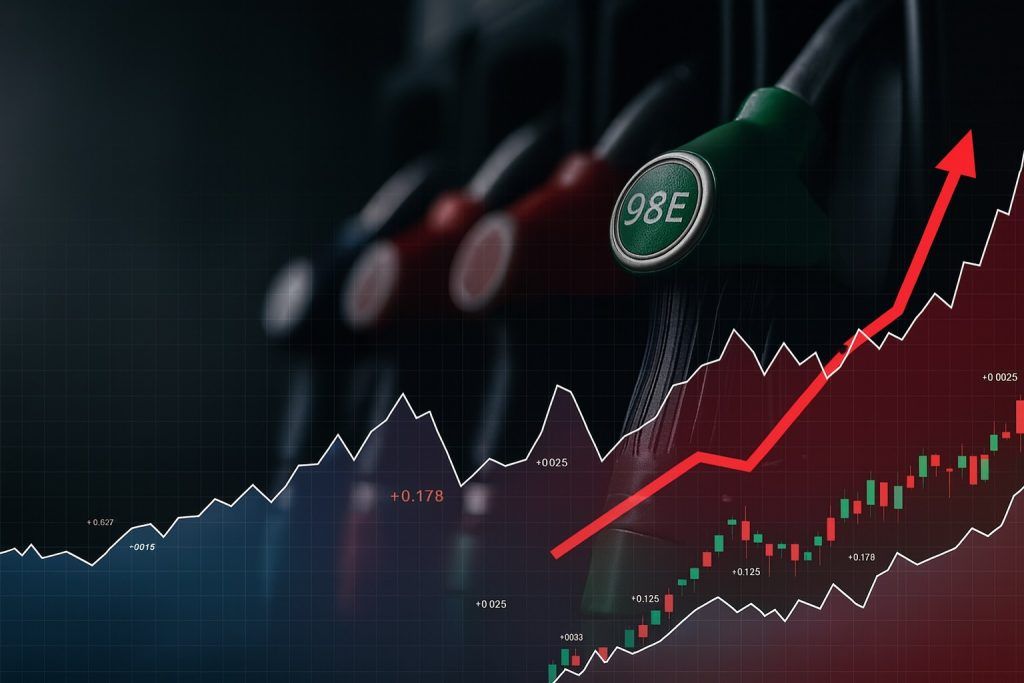- Current Price & Range: Robin Energy (NASDAQ: RBNE) trades around $1.27 per share as of Oct. 23, 2025, essentially flat on the day [1]. The stock is near the bottom of its 52-week range ($1.21 – $24.65) after a steep drop from this year’s highs [2].
- Recent Volatility: RBNE spiked nearly 100% intraday in mid-September after a Bitcoin investment announcement, jumping from ~$1.90 to $4.20 before settling ~20% higher at $2.30 [3]. It plunged 37% days later when a dilutive share offering was unveiled [4], underscoring extreme volatility.
- Financials & Growth: Robin Energy swung to profit with $0.5 million net income in Q2 2025 (up 150% YoY) on $2.0M revenue (+33%) [5], its first earnings since an April 2025 spinoff. The company doubled its fleet this year to 3 vessels (adding two LPG carriers) and ended June with a robust $39.4M cash reserve [6].
- Crypto Treasury Move: In a bold pivot, Robin Energy adopted Bitcoin as a treasury asset, allocating $5 million to BTC by September [7]. The CEO calls Bitcoin a “scarce digital asset” integral to the firm’s long-term strategy [8]. This crypto bet briefly boosted RBNE’s stock, but also ties it to Bitcoin’s swings.
- Investor Sentiment: Analysts caution that RBNE remains highly speculative. Technical signals are bearish (the stock sits in a falling trend with a “Strong Sell” daily rating [9]), and one algorithm predicts a further -50% drop (to ~$0.40–$0.80) in coming months if current trends persist [10]. Still, some see deep value – RBNE trades at only ~0.4× book value [11] – reflecting market skepticism but also potential upside if fundamentals improve.
Stock Performance: Wild Swings in Recent Days
Robin Energy’s stock has been on a rollercoaster in late 2025. Shares closed yesterday (Oct. 22) at $1.27, up 1.6% from the prior day’s $1.25 close [12]. In that session, RBNE oscillated between $1.21 and $1.29 (a 6.6% intraday swing) [13] on higher-than-average volume – about 495,000 shares traded, roughly double the previous day’s turnover [14]. This mild uptick broke a multi-day losing streak; the stock had fallen in 6 of the past 10 sessions, sliding ~3.8% over two weeks [15].
Despite this week’s stabilization, Robin Energy remains deep in the red for the year. At ~$1.27, RBNE is down ~95% from its 52-week peak. In fact, the stock’s year-high of $24.65 (reached earlier in 2025) now feels like a distant outlier [16]. Much of that decline occurred after summer, as a series of share issuances and profit-taking erased a mid-year spike. Notably, on the morning of September 10, RBNE briefly skyrocketed – opening above $4 and touching an intraday high of $4.20 – before closing that day around $2.30 [17] [18]. That surge was triggered by crypto-related news and market speculation (more below), and it demonstrated how explosive this micro-cap stock can be under the right conditions. Conversely, the crash back under $2 that followed showed how quickly gains can evaporate once reality (and dilution fears) set in.
It’s worth noting that even small trades can move RBNE dramatically. The stock’s float is only ~5.2 million shares and insiders still own ~10% [19], limiting liquidity. Early on Oct. 23, RBNE saw a pre-market price spike of over +50% (to nearly $1.95) on very thin trading [20] [21], despite no new developments – a sign of how speculative fever and algorithmic trading can whip this stock around. By mid-day, however, shares had settled back near the $1.25–1.30 range. For current and prospective investors, these whipsaw moves underscore the need for caution – RBNE’s price can swing wildly on minimal news, or even no news at all.
Recent Catalysts: Bitcoin Bet, Offerings, and New Vessels
Robin Energy Ltd. has made plenty of headlines in the past few months. Perhaps the most attention-grabbing was its unexpected pivot into cryptocurrency. Over the summer, the Cyprus-based company (which operates oil/chemical tankers) decided to adopt Bitcoin as a primary reserve asset, an unusual move for a shipping firm. The board approved an initial $5 million Bitcoin allocation in late July [22] [23], and by September 10 the company completed that purchase via Anchorage Digital Bank [24] [25]. CEO Petros Panagiotidis touted this as a forward-looking strategy, stating “We believe in Bitcoin’s unique characteristics as a scarce digital asset and see it as an integral component of our long-term strategy to grow our company and drive shareholder value” [26]. With that step, Robin Energy became the 110th public company to hold Bitcoin on its balance sheet [27].
The market’s reaction was immediate – and intense. When Robin’s crypto purchase was confirmed on Sep. 10, RBNE stock erupted. It jumped from around $1.90 to over $4.20 intraday on heavy trading [28], triggering multiple volatility halts. Social media chatter and at least one trading outlet reported “a major international partnership deal” in the works for Robin [29], which further fueled speculative buying. (No such partnership has since been announced, suggesting those reports were likely market rumors.) By the closing bell, RBNE settled at $2.30, still up +20% on the day [30] – a remarkable gain, though far off the peak as cooler heads prevailed. The intraday rally of nearly 100% and rapid pullback demonstrated both the upside frenzy and downside risk tied to Robin’s new crypto profile. In effect, investors were suddenly valuing the company not just as a tiny oil transporter, but also as a proxy for Bitcoin – with all the volatility that entails.
However, just as Robin Energy seemed to capture market momentum, it swiftly tapped into that optimism with a dilutive equity offering – catching many traders off guard. On September 10 (after hours, post-spike), the company announced plans to sell new shares to raise cash [31]. By the next morning (Sep. 11), Robin priced an offering of 5.77 million shares at $1.30 each – roughly a 48% discount to the prior day’s peak [32]. This offering (with a green shoe overallotment) ultimately raised $8.6 million gross [33], bolstering the balance sheet but diluting existing shareholders. Not surprisingly, RBNE’s stock price cratered on the news: it plunged ~38% from the day’s open to close well under $1.50 [34]. In a matter of 48 hours, Robin Energy went from euphoria and multi-dollar prices back to penny-stock territory. The episode left many investors with whiplash and some frustration – as one might expect when a company’s own financing move abruptly deflates a rally. (That said, raising capital at $1.30 was arguably prudent for Robin’s long-term growth, given the stock had traded near $1 just days before. Cash in the bank can be critical for a micro-cap’s survival, even if it comes at the expense of short-term share price.)
Aside from the crypto adventure, Robin Energy’s core business has been expanding steadily. The company specializes in energy transportation, owning and operating small ocean-going tankers for refined petroleum products and petrochemical gases. Until recently, Robin had a very minimal fleet – just a single Handysize tanker (the M/T Wonder Mimosa, ~36,700 dwt capacity) that came with the company’s formation. But management has been executing an ambitious growth plan: in July 2025 Robin announced the acquisition of a 5,000 cubic meter LPG carrier (Liquefied Petroleum Gas ship) for $18 million [35] [36], effectively doubling its fleet. This deal was a related-party transaction (the seller was Toro Corp., a Nasdaq-listed shipping firm controlled by Robin’s own CEO), so it was approved by independent directors to ensure fairness [37]. The LPG vessel – Dream Syrax – was delivered to Robin in early September and immediately began generating revenue under charter. In fact, as of Sep. 3 the Syrax is on a time-charter earning $337,000 per month through late December [38]. That contract provides a nice, steady cash inflow for the rest of 2025.
Then in mid-September, Robin revealed an even bigger expansion: the acquisition of a third vessel, another modern 5,000 m<sup>3</sup> LPG carrier (built 2020), for $20 million [39]. This ship – likely to be named Dream Terrax (sister to the Syrax) – is expected to join the fleet by the end of 2025. Robin Energy has said it will fund the purchase entirely with cash on hand [40], again highlighting the war chest it amassed from recent stock offerings. Once the deal closes, Robin Energy’s fleet will consist of 3 ships: two LPG carriers and one Handysize oil tanker [41]. This is a remarkable transformation from just a single-vessel operation at the start of the year. The expanded fleet positions Robin to serve a broader range of energy transport needs – from refined fuels and chemicals to liquefied gases – across multiple global routes. It also diversifies the company’s revenue streams: tankers and LPG ships have different market dynamics, and demand for LPG shipping in particular has been robust in some regions.
To support this growth, Robin Energy aggressively bolstered its finances earlier in 2025. In June (shortly after completing its spinoff from Toro Corp. in April), the company undertook four registered direct equity offerings, raising a total of $17.2 million in gross proceeds [42]. These summer financings, done at various prices (prior to the Bitcoin news), brought in much-needed capital. Indeed, thanks to those raises, Robin’s cash and equivalents swelled from essentially zero to $39.4 million by June 30, 2025 [43]. That liquidity funded the vessel acquisitions (costing ~$38M combined) and enabled the Bitcoin treasury allocation without hampering day-to-day operations [44] [45]. Impressively, Robin has managed to expand without taking on debt – its balance sheet remains debt-free as of the last report [46] [47], a rarity in the capital-intensive shipping industry. However, shareholders have paid the price via dilution: the share count has ballooned with each offering (now roughly 5.8 million outstanding, up from ~1.5M pre-June). The trade-off is clear – Robin Energy today owns a small fleet and a Bitcoin stash, but each share represents a smaller slice of that enlarged pie.
Strategic Context: Energy Shipping Meets Crypto Ambitions
Robin Energy sits at an unusual intersection of industries. On one hand, it’s a traditional energy shipping company – a niche, Cyprus-based owner of tankers that move oil products and LPG. On the other, it has dipped a toe into the cryptocurrency realm by reallocating some corporate treasury into Bitcoin. This hybrid identity is part deliberate strategy, part opportunistic move.
In terms of core operations, Robin is leveraging a favorable period in maritime markets. Global demand for transporting refined fuels and gases has been relatively strong in the wake of post-pandemic recovery and shifting trade patterns. LPG carriers, like the two Robin now owns, are benefiting from increased LPG use in emerging markets and petrochemical feedstocks. Product tankers (like Robin’s Handysize vessel) saw a boom in charter rates in 2022–2023 amid reshuffled oil flows (e.g. Europe importing more fuels from afar). Rates have moderated in 2024, but remain decent for efficient operators. Robin’s new ships are fully employed – notably, the charter on its LPG Dream Syrax at $337k/month [48] should contribute roughly $1 million revenue for the back half of 2025, helping underpin results. As a small player, Robin can’t compete on scale, but it can target high-margin niches or shorter routes where its handysize and mid-size vessels excel. The recent fleet expansion from 1 to 3 ships could unlock economies of scale (spreading overhead across more voyages) and make Robin a more relevant contractor to customers. It also positions the company to capitalize if energy shipping rates tick upward this winter – for example, any spike in heating fuel demand or arbitrage opportunities in LPG could mean higher utilization and pricing power for Robin’s vessels.
At the same time, management’s Bitcoin bet adds a new strategic dimension (and risk). By holding $5 million in BTC (purchased around August–September), Robin Energy essentially hitched part of its fortune to the cryptocurrency’s performance. The timing has been quite fortunate so far: Bitcoin prices have surged in 2025, reaching levels unseen in years. In fact, BTC recently soared past $100,000 and approached $120,000 in early October amid optimism over a possible U.S. Bitcoin ETF approval and pro-crypto moves from Washington [49]. That bull run has significantly increased the value of Robin’s crypto holdings – $5M invested a couple months ago would be worth substantially more today if still held. (For context, Robin’s 5 million USD allocation could equate to roughly 150–200 BTC; at ~$110k per coin, that’d be over $16–$20 million value – potentially exceeding the company’s entire market cap.) In theory, this hidden asset value could provide a cushion on the balance sheet or even attract investors who want exposure to Bitcoin via an alternative vehicle like RBNE.
However, the market hasn’t (yet) re-rated Robin Energy stock upward for its crypto holdings – likely because of skepticism and other overriding concerns. Unlike pure-play Bitcoin miners, which often skyrocket when BTC rises [50], Robin’s core business is unrelated to crypto, so many traditional energy investors may discount the Bitcoin as a side experiment. Additionally, shareholders know that crypto’s volatility cuts both ways. If Bitcoin were to plunge from its highs, Robin’s treasury would take a hit. The company has indicated it may adjust its Bitcoin allocation over time and is monitoring market conditions closely [51]. This suggests a cautious approach rather than a “set and forget” conviction like some crypto-focused firms. Still, Robin joining the ranks of companies with Bitcoin on the balance sheet puts it in novel territory. It’s essentially a shipping micro-cap that doubles as a tiny crypto asset holder. This dual nature could attract a wider investor base – or confuse it. For now, Robin Energy’s strategic bet on BTC is an intriguing sidebar: it hasn’t fundamentally altered operations, but it garnered short-term buzz and could pay off handsomely (or not) in the long run.
Expert Outlook: Cautious Optimism vs. High Risk
Most financial experts view Robin Energy as a high-risk, speculative play at this stage. The company’s bold moves (fleet growth, Bitcoin purchase) show promise, but have also introduced significant uncertainties. Traditional Wall Street analyst coverage of RBNE is sparse – this is a nano-cap stock (market value ~$16 million) that many research firms simply don’t track. Those that do cover it tend to highlight the volatile nature and urge caution. For instance, technical analysis indicators are largely negative on RBNE at present: the stock is trading below key moving averages and in a clear downtrend. Investing.com’s summary rates RBNE a “Strong Sell” on daily technical signals [52]. Similarly, StockInvest.us (an algorithm-driven service) notes “mixed signals” but overall bearish momentum, classifying Robin as a “hold” at best – not a buy – in the short term (as of Oct 21) [53]. Their model forecasts the downward trend will continue, projecting RBNE could fall into the $0.40–$0.80 range over the next 3 months with 90% probability if the current trajectory isn’t reversed [54]. Such a grim prediction underscores that momentum is not on Robin’s side unless new positive catalysts emerge.
On the other hand, a few observers point out that Robin Energy’s assets and financial metrics might justify a higher valuation if execution is solid. After the recent share issuances, the company’s book value per share is substantially above the stock price – in fact, RBNE trades at only about 0.37× its latest book value [55]. This implies the market is heavily discounting Robin’s ships, cash, and Bitcoin holdings. For contrarian investors, that could signal a potential bargain if they believe the business will stabilize and grow. The successful delivery and employment of new vessels and the profitable Q2 are positive signs. Continued profitability (or at least breakeven performance) in upcoming quarters would go a long way to building credibility. It’s notable that Robin is debt-free [56], which removes bankruptcy risk due to leverage – a common pitfall in the shipping sector. In essence, the company has been using equity (and now some crypto) to finance growth, avoiding loans. If managed prudently, this could keep interest costs low and give Robin flexibility to weather industry downturns.
Some market commentators have also mused that Robin Energy might eventually benefit from being a “pseudo-crypto” stock during Bitcoin bull runs. In late 2025, crypto-related equities (miners, crypto brokers, etc.) have seen outsized gains as Bitcoin hit all-time highs [57] [58]. While Robin’s stock didn’t hold its initial crypto-fueled spike, it’s conceivable that if Bitcoin stays elevated (or climbs further), RBNE could attract renewed speculative interest as a backdoor crypto play. That remains speculative – and it’s worth emphasizing Robin’s crypto position is relatively small (just a few million dollars worth). Still, in an age where even a whiff of blockchain can move a penny stock, it’s an angle to watch.
Industry experts also assess Robin Energy’s outlook within the context of the energy shipping market. The global tanker and LPG shipping sector in 2025 faces mixed conditions. Oil prices have been volatile – for example, Brent crude recently jumped over 5% in a single day to ~$66/barrel [59], driven by geopolitical tensions. Such oil swings can indirectly affect product tanker demand and fuel costs for shippers. Robin’s fortunes will partly ride on these external factors: If refining output and petro-gas trade remain high, its vessels should find ample employment. The new LPG carriers position Robin in a segment (LPG transport) that has shown strong long-term demand growth, tied to cleaner fuel adoption and petrochemical needs. That could be a tailwind. Conversely, any global recession or energy glut could soften freight rates, pinching the company’s shipping revenues. Additionally, as a very small operator, Robin lacks bargaining power and economies of scale that larger shipping firms enjoy, which is a competitive disadvantage.
Looking ahead, Robin Energy is expected to report Q3 2025 earnings in the coming weeks (around end of October or early November). Investors will be eager to see concrete numbers showing the initial contributions from the Syrax LPG vessel charter and any updates on the third vessel acquisition timeline. The Q3 report will also reveal if the company realized any accounting gains on its Bitcoin holdings (depending on how they treat the investment – either mark-to-market or as intangible asset). Positive earnings momentum – if Robin can follow its Q2 profit with another profitable or at least breakeven quarter – might start to shift sentiment. Conversely, any signs of operational hiccups (e.g. unexpected costs, downtime, or a decision to sell shares again) could reinforce bear cases.
At present, no major Wall Street analysts have issued formal price targets or ratings on RBNE that are publicly available. (One early small-cap research note in mid-2025 reportedly placed a speculative $19+ target on the stock when it was trading near $6 [60], but that was before the heavy dilution and is outdated.) More realistic commentary comes from those familiar with penny stock dynamics: expect turbulence. As veteran trader Tim Bohen observed during September’s action, “Robin Energy’s valuation may be painting a rosier picture than its reality… continual innovation catalyzes growth but invites scrutiny over price sustainability” [61]. In other words, even if Robin has a compelling story (Bitcoin! New ships! Profitable quarter!), the sustainability of its stock price gains remains in question until the company proves it can generate consistent returns.
Risks and Opportunities for Investors
Like any micro-cap stock, Robin Energy carries a mix of high risks and potential rewards. It’s important for investors to weigh these factors:
- Risks:
- Extreme Volatility & Low Liquidity – RBNE’s wild price swings (±50% moves in a day) highlight the danger for traders. The low float and speculative interest mean the stock can be whipsawed by rumors or rapid sell-offs, making it unsuitable for the faint of heart.
- Dilution & Financing – The company has issued new shares multiple times in 2025 to raise capital, sharply diluting existing shareholders [62] [63]. Future acquisitions or initiatives could be funded by more equity offerings, which may cap share price appreciation. Robin does have an effective shelf registration, so investors must be mindful of potential dilution events.
- Crypto Exposure – While Bitcoin has boosted Robin’s treasury value, it also introduces cryptocurrency risk. A significant drop in BTC’s price would directly erode the company’s assets and could hurt investor sentiment. Regulatory changes or crypto market crashes could therefore impact RBNE, even though shipping is its main business.
- Operational & Market Risk – As a small shipping firm with just a few vessels, Robin is vulnerable to any operational mishaps (mechanical issues, accidents, etc.) and to the cyclical nature of shipping rates. A downturn in oil demand or oversupply of product tankers/LPG carriers could squeeze its revenue. With one tanker and two LPG ships, concentration risk is high – the loss of a major charter or client could materially hit cash flow.
- Corporate Governance – Some of Robin’s deals (like buying ships from Toro Corp., run by its own CEO) pose related-party concerns [64]. While steps have been taken to ensure fair dealing, investors will want to see strong governance and independent oversight maintained, to avoid management enriching one entity at the expense of another.
- Opportunities:
- Asset Value & Cash Buffer – Robin Energy’s balance sheet is relatively strong for its size. It holds substantial cash (over $10M likely after recent deals) and no debt, plus the Bitcoin reserves. This provides a cushion for operations and growth. The stock’s low price-to-book ratio suggests the market isn’t fully valuing these assets [65]; if the company demonstrates improving earnings, there is room for re-rating upward.
- Growing Fleet & Revenue – With three ships by year-end, Robin’s carrying capacity and revenue potential have greatly expanded. Each new vessel (especially if employed on favorable charters) can significantly boost top-line and potentially bottom-line results. The company is effectively leveraging fresh capital into tangible, revenue-generating assets. If shipping markets stay robust or tighten further, Robin could see outsized earnings growth off a small base.
- Bitcoin Upside – The decision to allocate part of the treasury to Bitcoin could pay off handsomely if the crypto bull market continues. Bitcoin’s price is up dramatically in 2025 [66], and some analysts predict further upside. Robin’s BTC holdings (≈🌐) act as a high-beta asset: in a roaring crypto scenario, that stake could appreciate and add to the company’s net worth. Moreover, the very association with crypto might attract speculative traders to RBNE during bullish phases, as seen in September. This optionality on crypto is something most shipping peers don’t have.
- Sector Tailwinds – The broader energy and shipping sector backdrop has positives: global energy demand remains high, and supply-chain shifts (such as new trade routes for oil/LPG) can increase ton-mile demand for ships. If Robin Energy can carve out a niche, it might benefit from trends like the growth in LPG use (LPG is touted as a cleaner transitional fuel in Asia and elsewhere). Additionally, being a pure-play on product and gas shipping could make Robin an attractive partner or acquisition target for a larger maritime company looking to expand in that subsegment.
- Execution of Strategy – Thus far, Robin’s management has executed on what they planned: they raised capital, acquired vessels as promised, and even delivered a profitable quarter. If they continue to hit milestones (smooth integration of new ships, prudent treasury management, and maybe eventually share buybacks or dividends once stable), investor confidence could improve. A small company that successfully grows can sometimes be rewarded with exponential stock gains – if it can overcome the current trust deficit.
Bottom Line
Robin Energy Ltd. has had a remarkable year, packing more drama into a few months than some companies see in a decade. From spinning off into independence, to doubling its fleet, to taking a daring leap into Bitcoin, Robin has been reinventing itself at every turn. These moves have given investors plenty to digest – and the stock’s rollercoaster price action reflects both the excitement and uncertainty surrounding the company.
As of late October 2025, RBNE sits at a crossroads. The stock is cheap by the numbers (trading near all-time lows and at a fraction of asset value) yet it’s also highly speculative, still searching for a stable narrative. Bulls will argue that the pieces are falling into place: a cash-rich balance sheet, new revenue streams from additional vessels, a savvy (if unorthodox) Bitcoin hedge, and early evidence that Robin can turn a profit. Bears will counter that the company’s micro-cap status and volatile strategy make it unpredictable – and that previous spikes have been short-lived once reality set in. Both sides would likely agree on one thing: Robin Energy is not your average shipping stock. It straddles traditional and emerging sectors in a way few peers do.
For investors, the key going forward will be execution and transparency. Watch for Robin’s upcoming financial results to see if the positive Q2 momentum continues. Keep an eye on how management stewards the treasury (will they hold or tweak the Bitcoin stake?) and whether they can avoid constant dilution now that cash levels are healthy. Any further strategic partnerships or contracts – perhaps long-term charters for its vessels, or collaborations leveraging its crypto holdings – could also be game-changers. In the meantime, expect RBNE to remain headline-driven. Sudden surges or drops on news (or rumors) are likely to continue given the stock’s nature.
Bottom line: Robin Energy offers a high-risk “story stock” scenario – it has a bold storyline at the intersection of energy transport and cryptocurrency in 2025, which could either catalyze a turnaround or lead to more turbulence. Savvy traders might trade the swings, while long-term investors should size positions carefully (or sit on the sidelines) until clearer trends emerge. As one market expert quipped, when a stock like RBNE is in play, “Preparation is half the trade” [67]. In other words, know what you own and be prepared for anything – because with Robin Energy, expect the unexpected has truly been the rule this year.
Sources: Recent company press releases and financial filings [68] [69], stock exchange data [70] [71], and expert commentary from market analysts and news outlets [72] [73] were used in compiling this report. All information is up to date as of October 23, 2025.
References
1. www.investing.com, 2. www.investing.com, 3. www.coinspeaker.com, 4. www.stocktitan.net, 5. www.stocktitan.net, 6. www.stocktitan.net, 7. www.stocktitan.net, 8. finviz.com, 9. www.investing.com, 10. stockinvest.us, 11. www.reuters.com, 12. stockinvest.us, 13. stockinvest.us, 14. stockinvest.us, 15. stockinvest.us, 16. www.investing.com, 17. www.coinspeaker.com, 18. www.coinspeaker.com, 19. www.stocktitan.net, 20. seekingalpha.com, 21. seekingalpha.com, 22. www.stocktitan.net, 23. www.stocktitan.net, 24. www.stocktitan.net, 25. www.stocktitan.net, 26. finviz.com, 27. www.coinspeaker.com, 28. www.coinspeaker.com, 29. stockstotrade.com, 30. www.coinspeaker.com, 31. www.stocktitan.net, 32. www.stocktitan.net, 33. www.stocktitan.net, 34. www.stocktitan.net, 35. www.stocktitan.net, 36. www.stocktitan.net, 37. www.stocktitan.net, 38. www.stocktitan.net, 39. www.stocktitan.net, 40. www.stocktitan.net, 41. www.stocktitan.net, 42. www.stocktitan.net, 43. www.stocktitan.net, 44. www.stocktitan.net, 45. www.stocktitan.net, 46. www.reuters.com, 47. www.reuters.com, 48. www.stocktitan.net, 49. ts2.tech, 50. ts2.tech, 51. www.stocktitan.net, 52. www.investing.com, 53. stockinvest.us, 54. stockinvest.us, 55. www.reuters.com, 56. www.reuters.com, 57. ts2.tech, 58. ts2.tech, 59. www.reuters.com, 60. app.tiingo.com, 61. stockstotrade.com, 62. www.stocktitan.net, 63. www.stocktitan.net, 64. www.stocktitan.net, 65. www.reuters.com, 66. ts2.tech, 67. stockstotrade.com, 68. www.stocktitan.net, 69. www.stocktitan.net, 70. www.investing.com, 71. stockinvest.us, 72. www.coinspeaker.com, 73. ts2.tech







